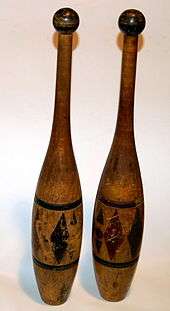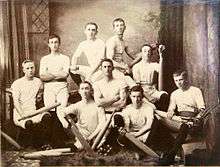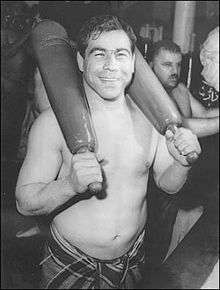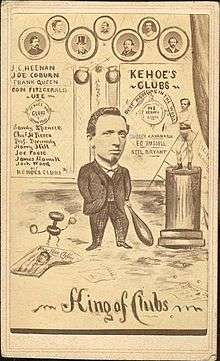Indian club

Indian clubs or meels are a type of exercise equipment used for developing strength. They comprise bowling-pin shaped wooden clubs of varying sizes and weights, which are swung in certain patterns as part of an exercise program. They can range from a few pounds each, up to special clubs that can weigh as much as 50 pounds. They were used in carefully choreographed routines where the clubs were swung in unison by a group of exercisers, led by an instructor in the front, similar to modern aerobics classes. The routines varied according to the group's ability and the weight of the clubs used.
Despite their common English name implying an Indian origin, the so-called Indian clubs were in fact created in the Near East. Properly referred to as meels (Persian: میل, translit. mil), they are first recorded as being used by wrestlers in ancient Persia, Egypt and the rest of the Middle East. The practice has continued to the present day, notably in the varzesh-e bastani tradition practiced in the zurkaneh of Iran. From Persia, the Mughals brought meels to South Asia where they are still used by pehlwan (wrestlers) in South Asia today. British colonists first came across meels in India, and erroneously referred to them as "Indian clubs" despite their Middle Eastern origin.



_-_Yazd_-_Central_Iran.jpg)
They were exceptionally popular during the health craze of the late Victorian era, used by military cadets and well-heeled ladies alike, and even appeared as a gymnastic event in the 1904 and 1932 Olympics. Gymnasia were built just to cater to club exercise groups. During the late 19th and early 20th centuries they became increasingly common in Europe, the British Commonwealth and the United States.
Circa 1913/14 the Bodyguard unit of the British suffragette movement carried Indian clubs as concealed weapons for use against the truncheons of the police.
The popularity of meels waned in Europe during the 1920s and 1930s as organized sports became more popular. Regimented exercise routines, like those requiring meels, were relegated to professional athletes and the military, who had access to more effective and modern strength training equipment.
While torches and other stick-like objects have been used in juggling for centuries, the modern juggling club was inspired by meels, which was first repurposed for juggling by DeWitt Cook in the 1800s.
There are current physical fitness enthusiasts who have revived the popularity of meels in the modern day, citing the aerobic exercise and safety advantages over traditional free weight regimens. There are nostalgic replicas of the original clubs being manufactured, as well as modern engineering updates to the concept, such as the Clubbell.[1]
See also
- Kettlebell
- Newark Athlete
- Toss juggling
- Gymnastics at the 1904 Summer Olympics – Men's club swinging and Gymnastics at the 1932 Summer Olympics – Men's Indian clubs
References
- ↑ Clubbell Training stumptuous.com
External links
| Wikimedia Commons has media related to Meels. |
- Indian Club Exercise, by Sim D. Kehoe, 1866
- Documentary video of Iranian Club Swinging
- Exercises with Clubs, by Dio Lewis, M.D., 1862